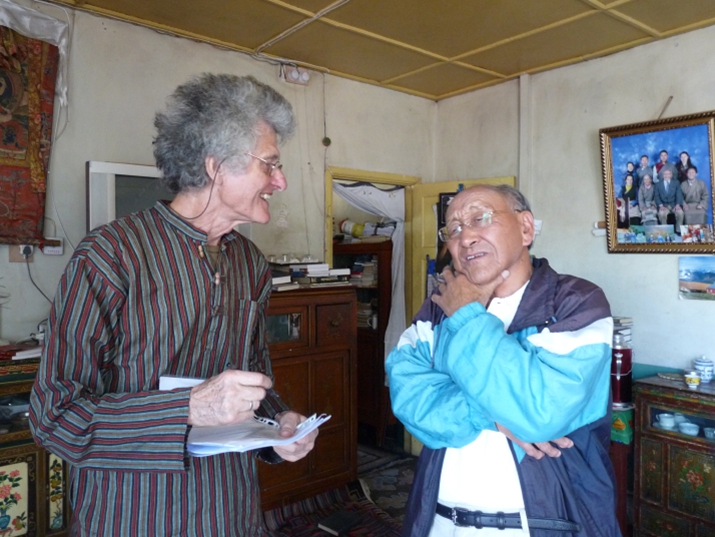| China |
| A Belgian Tibetologist sets the record straight | |
|
|
 André Lacroix (left) meets with Tashi Tsering on August 21, 2009 (COURTESY PHOTO)
Over the past 70 years, living standards in Tibet have improved dramatically; language, culture and religion in this autonomous region have been fully protected. These are indisputable facts, Belgian Tibetologist André Lacroix said in a recent interview with Beijing Review. Lacroix, a retired secondary school teacher, has been studying Tibet for more than two decades and has made several trips to the autonomous region and other Tibetan-inhabited areas in China. In 2019, he published Dharamsalades—Les masques tombent (literal translation: Dharamsalades—The Masks Fall Off), a tongue-in-cheek reference to the fake news from Dharamsala, where he un-covers the actual facts behind the 14th Dalai Lama's fabrications about Tibet and reveals in sharp-witted style the true ambitions of the Tibetan monk. A different reality Like most Westerners, based on Western media reports, Lacroix, too, believed that Tibetans had fallen victim to a purported "cultural genocide." It was only during a trip in 1999 that he was able to shatter all those allegations and suppositions, witnessing firsthand a world of difference between the real Tibet and the continuously claimed clichés about the region. His daughter was studying in Kunming, capital of Yunnan Province, in the 1990s and as Lacroix and his wife Thérèse De Ruyt came to visit her, they traveled to Gansu, Sichuan and Yunnan provinces, where ethnic Tibetans reside across autonomous counties and prefectures. "I was astonished to see the sheer number of magnificent monasteries crowded with monks in Xiahe of Gansu, Langmusi of Sichuan or Zhongdian of Yunnan! Some monasteries were being renovated and richly decorated," Lacroix said. He fondly remembered attending a Buddhist ceremony inside a prayer hall, filled with sacred music and the fumes of oil lamps. Much to his surprise, following the ceremony, a throng of young monks gathered noisily in the forecourt. "Everywhere in the streets, and even in restaurants, you could see monks, young and old. This spectacle did not quite fit into what I thought would be a monastic Tibet experiencing a 'crackdown'," he reckoned. Such discrepancies with the Western narrative prompted Lacroix to focus exclusively on Tibetan studies after his retirement from teaching. He translated The Struggle for Modern Tibet, the memoirs of former Tibetan peasant-turned-scholar Tashi Tsering, and decided the time had come for him to pay Tibet a visit in person. Lacroix met up with Tashi Tsering twice, in 2009 and 2012, and the men immediately forged a solid bond. During one of their talks, Lacroix learned about the peaceful liberation of Tibet back in 1951. Tashi Tsering told him that before 1951, Tibet had no schools worthy of the name, only 2 percent of children actually received education and the illiteracy rate stretched as high as 95 percent. Children like Tashi Tsering himself stood no chance to receive a decent education. After decades of development, formal schooling was made a reality in Tibet, and since 1986, a nine-year compulsory education scheme, free of charge, has been established across the country. What's more, the Tibetan language is part of the obligatory curriculum in Tibet.  Tibetan dancers perform the Jiuhezhuo Dance, a national-level intangible cultural heritage item, in Shannan, Tibet Autonomous Region, on May 22 (XINHUA)
Solving 'eco' dilemmas Lacroix found himself amazed by the rapid development of Tibet over the past seven decades. "Lhasa, which was only a modest village three quarters of a century ago, today has become a real capital with wide avenues. The historic center has gradually been restored in its traditional style with modern amenities," he noted. Upon first setting foot on Lhasa soil, he also observed just how efficiently rail and road infrastructure had been executed, with optimal, user-friendly connections in place. Question remains: Is economic development compatible with ecological protection? Lacroix said during the interview that at the time, he did have his concerns, but his two trips to Tibet eventually dispelled his doubts. "The authorities have created huge national and regional parks for the conservation of endangered animal species. On the high-altitude grasslands threatened by global warming and overgrazing, we could see millions of small patches of grass, and massive reforestation," he remarked. "While driving along the Yarlung Zangbo river toward Tsetang, my wife, who really likes taking pictures through the window, had to ask our driver to pull over. The curtain of trees on the road was so thick that she couldn't even take a picture of the river," he reminisced. Lacroix was also impressed with the widespread use of renewable energy sources. "Tibet being one of the sunniest parts of the world, photovoltaic energy is highly developed, either in large public facilities or for private use in the most remote places," he said. He even witnessed shepherds recharging their smartphones using small solar panels sitting atop the mountain pastures. The phenomenal progress and the rapid development of Tibet are to be put to the credit of government policies, conceded Lacroix. "This is not something new. As early as 1951, soldiers of the People's Liberation Army were warmly received by the Tibetan people. These young soldiers built the roads, the schools, and the dispensaries. Tashi Tsering wrote in The Struggle for Modern Tibet that "[the soldiers] wouldn't have taken anything from the people, not even a needle." According to Lacroix, the Chinese Central Government is providing massive human, material and financial support to Tibet Autonomous Region to develop its economy and raise the living standards of its population. "Preferential policies in terms of family planning, education, environment and taxation go hand in hand with the protection of the Tibetan language, culture and religion," he concluded in the interview with Beijing Review. (Print Edition Title: Debunking the Myths) Copyedited by Elsbeth van Paridon Comments to liuyunyun@bjreview.com |
|
||||||||||||||||||||||||||||
|
